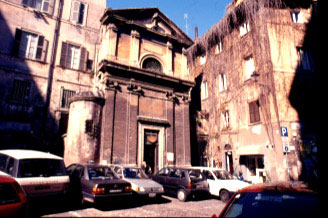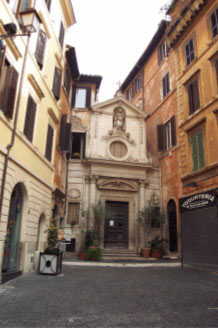The Theater in Antiquity - I
The Theater in Antiquity - II
The Theater in the Middle Ages
The Theater in the Early Modern Era
The Theater in the Modern Era
The Theater in the Middle Ages
By Kristin Triff
While the fortunes of the Theater in the early Middle
Ages are unknown, it appears to have retained its architectural
integrity for several centuries. Since the Einsiedeln
Itinerary (a late eighth-century pilgrim’s guide to Rome) refers
specifically to a theatrum near the Church of San Lorenzo
in Damaso, some of Pompey’s buildings may still have been intact at
that time. By the eleventh century, however, the theater had
been partially converted to other uses.
 |
|
|
| Santa Maria di Grotta Pinta (deconsecrated, with
seventeenth-century façade) |
These uses include the two churches
that occupy parts of the site, the 11th century
church of Santa Barbara (now Santa Barbara dei Librai, or Saint
Barbara of the booksellers), located near the southern extremity of
the cavea, and the church of Santa Maria di Grottapinta
(“Holy Mary of the painted grotto”) just above the midline of the
cavea. This ancient church, whose earliest surviving
documentation dates from 1186 C.E., was named for the rooms below
the church itself, which were probably the part of an original
access corridor to the cavea. Although the
orientation of the church was reversed in the seventeenth century
and thus the current façade dates to this period, the footprint of
the church remained essentially the same from the Middle Ages
through its deconsecration in the early twentieth century.
 |
|
|
| Santa Barbara dei Librai
(seventeenth-century
façade) |
By the mid-twelfth
century, at least two sources still identified the Theater by its
ancient name, while another cities it only as the “Temple of Cneus
(sic) Pompey,” a possible reference to the remains of the Temple of
Venus Victrix which was incorporated into the current Palazzo Pio on
Piazza Biscione. Ten years later (1150 C.E.), the archives of
the Orsini family indicate that “Iohannes de Ceca,” the prior and
financial officer of the church of Sant’Angela in Pescheria (“prior
et yconomus venerabilis Diaconie S. Angeli”), sold part of a
“trullum” to Bobone di Bobone and his heirs. In medieval
Latin, “trullum” derived from the Latin
turris, or tower,
and possibly incorporated the Latin
trulla, or round
structure. Bobone was a direct ancestor of the Orsini family,
one of Rome’s most powerful feudal families, and this sale marks the
beginning of a long association between the Orsini and the remains
of Pompey’s Theater.
 |
|
|
| View of Palazzo Pio looking east from the Campo
de’ Fiori towards the torre dell’ orologio
(Antonio Tempesta, 1606) |
By the end of the thirteenth century, the Boveschi-Orsini had
consolidated their holdings in the southern half of the Theater
through numerous property acquisitions, which included the large
torre dell’orologio, or clocktower built directly atop the
foundation of the Temple of Venus Victrix. The most frequently
cited landmark in the area until its partial destruction in the
seventeenth century, this tower dominated the area around Campo de’
Fiori and was the heart of the Orsini stronghold at this site.
The Orsini palace at Pompey’s Theater was an important link in the
chain of fortified Orsini family properties in the Tiber bend area
of Rome that controlled traffic across the river during the
factional conflicts of the later Middle Ages and
Renaissance.
